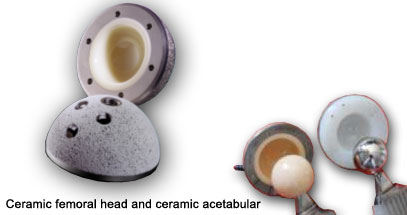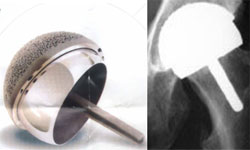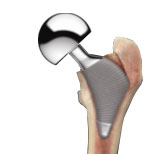1) Newer bearing surfaces (articulating interface)
Total hip replacements wear out because of wearing out of the polyethylene (plastic) which is used as a cup in the acetabular socket. Technological advancement has made it possible to design “Highly Cross-linked Polyethylene” which has better wear characteristics, and therefore last longer. There is also an interest in using harder surfaces (like metal-on-metal ceramic-on-ceramic and ceramic-on-metal) as bearing surfaces which have better wear characteristics. Short-term and medium-term studies have shown encouraging results with the use of these materials.

2) Hip Resurfacing Surgery
As opposed to a conventional hip replacement where the head and part of the neck of the femur (thigh bone) is removed, in resurfacing most part of the head of femur and the whole of the neck are preserved. A metallic crown is cemented on the remaining head. The acetabular socket is prepared and a thin shell of metal is impacted into it without using any cement.
This type of implant can only be used in early cases of arthritis or avascular necrosis where the head is not grossly destroyed. It cannot be used in patients with fractured hips. The advantage with this type of surgery is that patients are able to rehabilitate faster and are able to squat and sit cross-legged.
3) Minimally Invasive (Incision) Total Hip Replacement (MI THR)
Total hip replacement using a smaller incision has been described by some authors. The obvious advantage is the smaller scar and decreased tissue trauma which allows faster wound healing and surgical morbidity. However the technically it makes the procedure very demanding and requires specialized equipment. Moreover there are some serious concerns about “limited visibility and access” to the operating surgeon which may lead to components being placed in less than optimum position which can affect the eventual outcome. At the present moment it is not a universally accepted and recommended technique.

